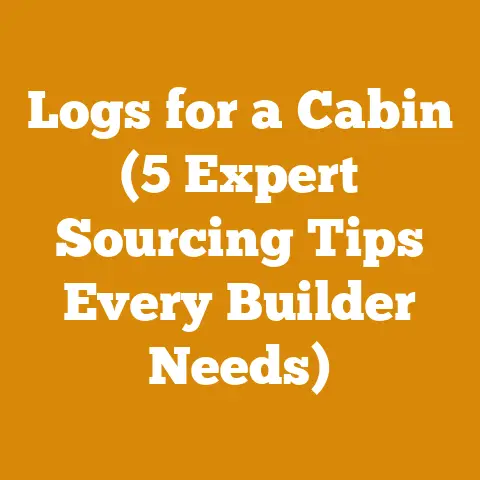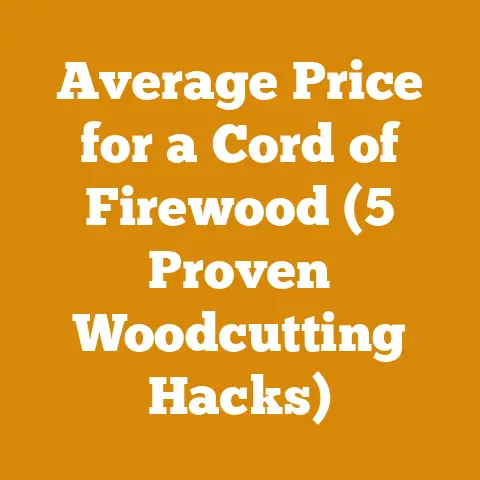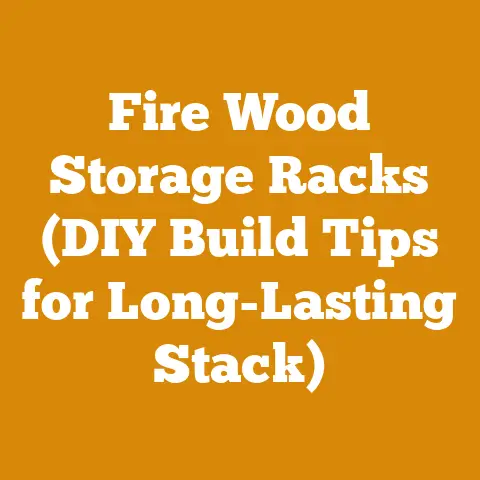Brick Hearth for Wood Stove Build (DIY Tips for Firewood Users)
Building a brick hearth for a wood stove is more than just a weekend project; it’s an investment in the warmth, safety, and aesthetics of your home. It’s about creating a cozy haven, a place where the crackling fire becomes the soundtrack to winter evenings. But before you dive into the satisfying work of laying bricks and feeling the heat of a wood stove, it’s crucial to understand the costs involved. As someone who’s spent years felling trees, splitting wood, and yes, even building my own brick hearth, I can tell you firsthand that proper planning is the key to a successful and budget-friendly project. So, let’s roll up our sleeves and get down to the nitty-gritty of budgeting for your brick hearth build.
Brick Hearth for Wood Stove Build (DIY Tips for Firewood Users)
A brick hearth isn’t just a pretty addition to your home; it’s a critical safety feature for any wood-burning stove. It provides a non-combustible surface, protecting your floors from stray embers and the intense heat radiating from the stove. Building one yourself can be a rewarding experience, saving you money and allowing you to customize the look to perfectly match your home’s style. However, like any DIY project, understanding the costs involved upfront is essential to avoid unwelcome surprises.
Understanding the Costs: A Deep Dive
The cost of building a brick hearth for a wood stove can vary widely depending on several factors. These include the size of the hearth, the type of bricks you choose, the materials needed for the foundation, and whether you hire any professional help. I’ve seen projects range from a few hundred dollars for a basic, DIY installation to several thousand for a larger, more elaborate hearth built by a contractor.
Variable Factors Affecting Project Costs
Before we break down the specific costs, let’s acknowledge the key variables that will influence your budget:
- Size of the Hearth: A larger hearth requires more materials, obviously increasing the cost. Building codes often dictate minimum hearth size based on the stove’s design.
- Type of Bricks: Brick prices vary significantly depending on the type, color, and quality. Common clay bricks are the most affordable, while firebricks, specially designed to withstand high temperatures, are more expensive. Decorative bricks or pavers can add to the cost as well.
- Foundation Requirements: The foundation is the base upon which your hearth will rest. If you’re building on a concrete slab, the foundation preparation will be minimal. However, if you’re building on a wooden floor, you’ll need to reinforce the floor and potentially build a raised hearth, significantly increasing the cost.
- DIY vs. Professional Installation: Doing the work yourself will save you on labor costs, but it requires time, skill, and the right tools. Hiring a professional ensures the job is done correctly and safely, but it comes with a significant price tag.
- Location: Material costs can vary depending on your location. Transportation costs and local market conditions play a role in the prices you’ll pay for bricks, mortar, and other supplies.
- Permits: Depending on your local building codes, you may need a permit to install a wood stove and hearth. Permit fees can add to the overall cost.
- Tools: While you may already own some of the necessary tools, you might need to purchase or rent specialized equipment like a brick saw or a mortar mixer.
Breaking Down the Cost Components
Let’s dissect the cost components to give you a clearer picture of where your money will go.
1. Bricks
Bricks are the most visible and arguably the most important component of your hearth.
- Common Clay Bricks: These are the most affordable option, typically costing between $0.50 and $1.50 per brick. They are suitable for the decorative portion of the hearth but should not be used directly under the wood stove where they will be exposed to extreme heat.
- Firebricks: These bricks are designed to withstand the high temperatures of a wood stove and are essential for the area directly under the stove. Firebricks typically cost between $2 and $5 per brick.
- Pavers: Pavers can be used for hearths and come in a variety of materials, including brick, concrete, and stone. The price of pavers varies widely, from $2 to $10 or more per paver, depending on the material and design.
- Quantity Calculation: To determine how many bricks you need, calculate the square footage of your hearth and then estimate the number of bricks per square foot. A standard brick is approximately 8 inches long and 4 inches wide, so it takes about 4.5 bricks to cover one square foot (including mortar joints). Don’t forget to add a 10% overage to account for cuts and breakage.
Example:
Let’s say you’re building a hearth that is 4 feet wide and 5 feet deep, totaling 20 square feet. You’ll need approximately 20 sq ft * 4.5 bricks/sq ft = 90 bricks. Adding a 10% overage, you’ll need to purchase about 99 bricks.
Personal Story:
I once tried to save a few bucks by using reclaimed bricks for a hearth I was building in my cabin. While the bricks looked great, they were of varying sizes and qualities, making the installation process a nightmare. I ended up spending more time and effort trying to make them fit together than if I had just bought new, uniform bricks. Lesson learned: sometimes, the cheapest option isn’t the best.
2. Mortar
Mortar is the glue that holds your bricks together. The type of mortar you use is crucial for the durability and safety of your hearth.
- Type S Mortar: This is a strong, general-purpose mortar suitable for most brick hearth applications. A 70-pound bag typically costs between $15 and $25.
- Refractory Mortar: This specialized mortar is designed to withstand high temperatures and is essential for use with firebricks directly under the wood stove. Refractory mortar can cost between $30 and $50 per bag.
- Quantity Calculation: A 70-pound bag of mortar will typically cover about 20-30 square feet of brickwork, depending on the thickness of the mortar joints.
Example:
For our 20 square foot hearth, you’ll likely need one bag of mortar. However, if you’re using wider mortar joints, you might need two bags.
3. Foundation Materials
The foundation is the unseen but crucial base of your hearth. The materials you need will depend on your existing floor.
- Concrete Slab: If you’re building on a concrete slab, you may only need a thin layer of mortar to level the surface. The cost will be minimal, perhaps $10-$20 for a small amount of mortar mix.
- Wooden Floor Reinforcement: Building a hearth on a wooden floor requires significant reinforcement to support the weight of the bricks. This may involve adding extra joists, plywood subflooring, and a layer of cement board.
- Lumber (Joists, Plywood): Prices vary widely depending on the type and grade of lumber. Expect to pay between $50 and $200 for the necessary lumber.
- Cement Board: This fire-resistant board is placed on top of the subflooring to protect the wood from heat. A 3′ x 5′ sheet of cement board typically costs between $15 and $30.
- Raised Hearth: A raised hearth involves building a frame, often from wood or metal studs, and then filling it with concrete or other non-combustible materials.
- Framing Materials (Wood or Metal Studs): The cost will depend on the size of the frame and the materials you choose. Expect to pay between $50 and $150.
- Concrete Mix: If you’re filling the frame with concrete, a bag of concrete mix typically costs between $5 and $10. You’ll need to calculate the volume of the frame to determine how many bags you need.
- Gravel: Gravel is often used as a base layer in a raised hearth to improve drainage and stability. A cubic yard of gravel typically costs between $30 and $50.
Example:
If you’re reinforcing a wooden floor, you might need:
- $100 for lumber
- $30 for cement board
- $20 for screws and fasteners
Total foundation cost: $150
4. Tools and Equipment
You’ll need a variety of tools to build your brick hearth. While you may already own some of these, you might need to purchase or rent others.
- Trowel: Essential for applying mortar. A good quality trowel costs between $15 and $30.
- Mortar Mixing Tub: A large tub for mixing mortar. A plastic tub costs between $10 and $20.
- Level: To ensure your hearth is level. A good quality level costs between $20 and $40.
- Brick Saw: For cutting bricks to size. You can rent a brick saw for around $50-$100 per day, or purchase one for $200-$500.
- Chisel and Hammer: For shaping and breaking bricks. A chisel and hammer set costs between $15 and $30.
- Safety Glasses and Gloves: Essential for safety. Expect to pay around $10-$20 for a good pair of safety glasses and gloves.
- Measuring Tape: For accurate measurements. A good quality measuring tape costs between $10 and $20.
Example:
If you need to rent a brick saw for a day, and purchase a trowel and safety glasses, your tool cost might be:
- Brick saw rental: $75
- Trowel: $25
- Safety glasses: $15
Total tool cost: $115
5. Labor Costs (If Applicable)
If you’re hiring a professional to build your hearth, labor costs will be a significant factor.
- Hourly Rate: Bricklayers typically charge between $50 and $100 per hour.
- Project-Based Pricing: Some contractors may offer a fixed price for the entire project. This can be a good option if you want to know the total cost upfront.
- Factors Affecting Labor Costs: Labor costs will depend on the complexity of the project, the contractor’s experience, and your location.
Example:
If you hire a bricklayer who charges $75 per hour, and the project takes 20 hours, your labor cost will be $1500.
6. Permits
Depending on your local building codes, you may need a permit to install a wood stove and hearth.
- Permit Fees: Permit fees vary widely depending on your location. Expect to pay between $50 and $200 for a permit.
- Inspection Fees: You may also need to pay for inspections to ensure the installation meets code requirements.
Example:
Let’s assume your permit fee is $100.
Case Study: Cost Breakdown for a DIY Brick Hearth
Let’s put it all together with a realistic example. Imagine you’re building a 4′ x 5′ brick hearth on a concrete slab. You’ll be doing all the work yourself.
- Bricks (Common Clay): 99 bricks x $1.00/brick = $99
- Mortar (Type S): 1 bag x $20/bag = $20
- Tools (Trowel, Safety Glasses): $40
- Permit: $100
Total Cost: $259
Now, let’s consider the same hearth, but this time you’re hiring a professional to do the work.
- Materials (Bricks, Mortar, etc.): $159 (same as above, but the contractor may mark up the price slightly)
- Labor: 20 hours x $75/hour = $1500
- Permit: $100
Total Cost: $1759
As you can see, the labor cost can significantly increase the overall cost of the project.
Current Industry Benchmarks and Statistical Data
To give you a better sense of the market, here are some current industry benchmarks and statistical data:
- Average Price per Cord of Firewood: According to the U.S. Energy Information Administration (EIA), the average price per cord of firewood varies widely depending on location and wood type, but it typically ranges from $200 to $400. This highlights the value of being able to process your own firewood, which is why a good hearth is so important.
- Average Cost of Wood Stove Installation: According to HomeAdvisor, the average cost to install a wood stove ranges from $1,200 to $4,500, including the cost of the stove, chimney, and hearth.
- Timber Prices: Timber prices fluctuate based on supply and demand, but you can find current market reports from organizations like the Forest Products Review and the Timber Mart-South.
Practical Tips for Cost Optimization and Budget Management
Building a brick hearth doesn’t have to break the bank. Here are some practical tips for cost optimization and budget management:
- Shop Around for Materials: Don’t settle for the first price you see. Get quotes from multiple suppliers to find the best deals on bricks, mortar, and other materials.
- Consider Using Reclaimed Materials: Reclaimed bricks can be a cost-effective and environmentally friendly option. Just make sure they are in good condition and suitable for use in a hearth. Be cautious as I said above.
- Do as Much of the Work Yourself as Possible: Even if you hire a professional for some of the work, you can save money by doing the demolition, site preparation, and cleanup yourself.
- Plan Ahead: Careful planning can help you avoid costly mistakes. Take the time to measure accurately, research building codes, and create a detailed plan before you start the project.
- Buy in Bulk: If you’re building a large hearth or have other projects planned, consider buying materials in bulk to save money.
- Look for Sales and Discounts: Many home improvement stores offer sales and discounts on building materials throughout the year. Keep an eye out for these opportunities.
- Negotiate with Contractors: Don’t be afraid to negotiate with contractors to get the best price. Get multiple quotes and compare them carefully.
- Consider Alternative Materials: While brick is a classic choice for hearths, you could also consider using stone, tile, or concrete pavers. These materials may be more affordable or easier to install.
Calculating Volume of Logs and Estimating Drying Time
As a firewood user, understanding how to calculate the volume of logs and estimate drying time is essential for efficient wood processing.
- Calculating Volume of Logs: The volume of a log can be estimated using the Doyle Log Scale, which is a common method in the United States. The formula is: (Small End Diameter in Inches – 4)2 x Length in Feet / 16. This will give you the volume in board feet.
- Estimating Drying Time: The drying time for firewood depends on several factors, including the type of wood, the size of the pieces, the climate, and how well the wood is stacked. As a general rule, hardwoods like oak and maple need to dry for at least 6-12 months, while softwoods like pine can dry in 3-6 months. You can use a moisture meter to check the moisture content of the wood. Firewood should have a moisture content of 20% or less for optimal burning.
Personal Story:
I remember one year I was in a rush to get firewood seasoned before winter. I stacked the wood too tightly, and it didn’t get enough airflow. By the time winter rolled around, the wood was still damp and didn’t burn well at all. I learned the hard way that proper stacking is just as important as the type of wood you use.
Relevant Calculations and Formulas
Here are some relevant calculations and formulas that can help you with your brick hearth project:
- Area of a Rectangle: Area = Length x Width
- Volume of a Rectangular Prism: Volume = Length x Width x Height
- Number of Bricks Needed: Number of Bricks = Area of Hearth x Bricks per Square Foot (approximately 4.5 bricks/sq ft)
- Mortar Coverage: Check the manufacturer’s instructions on the mortar bag for coverage information.
- Concrete Volume: Calculate the volume of the space you need to fill with concrete and then use a concrete calculator to determine how many bags of concrete mix you need.
Challenges Faced by Small-Scale Loggers and Firewood Suppliers
Small-scale loggers and firewood suppliers face numerous challenges, including:
- Fluctuating Timber Prices: Timber prices can be unpredictable, making it difficult to plan and budget.
- High Equipment Costs: Chainsaws, splitters, and other logging equipment can be expensive to purchase and maintain.
- Labor Costs: Hiring reliable and skilled labor can be a challenge, especially in rural areas.
- Regulations and Permits: Logging and firewood harvesting are often subject to strict regulations and permit requirements.
- Competition: Small-scale operators often face competition from larger, more established companies.
- Seasonality: Firewood sales are typically seasonal, with most demand occurring in the fall and winter.
Compelling Phrases That Drive Interest
Here are some compelling phrases that can drive interest in your brick hearth project:
- “Transform your living room into a cozy retreat with a beautiful brick hearth.”
- “Add value and warmth to your home with a DIY brick hearth project.”
- “Save money and create a custom look with a DIY brick hearth.”
- “Enjoy the warmth and ambiance of a wood stove with a safe and stylish brick hearth.”
- “Master the art of wood burning with a well-built brick hearth.”
Actionable Takeaways and Next Steps
Building a brick hearth for your wood stove is a rewarding project that can add value, warmth, and safety to your home. By understanding the costs involved, planning carefully, and following these tips, you can create a beautiful and functional hearth that will last for years to come.
Here are some actionable takeaways and next steps:
- Assess Your Needs: Determine the size and style of hearth you want to build.
- Research Building Codes: Check your local building codes to ensure your hearth meets all requirements.
- Create a Detailed Plan: Draw a detailed plan of your hearth, including dimensions and materials.
- Get Quotes: Get quotes from multiple suppliers for materials and labor (if applicable).
- Obtain Permits: Obtain any necessary permits before starting the project.
- Gather Your Tools and Materials: Make sure you have all the tools and materials you need before you start working.
- Follow Safety Precautions: Wear safety glasses and gloves when working with bricks and mortar.
- Take Your Time: Don’t rush the project. Take your time to ensure the hearth is built correctly and safely.
- Enjoy Your New Hearth: Once the hearth is complete, enjoy the warmth and ambiance of your wood stove!
A Final Thought
Building a brick hearth is a labor of love. It’s about more than just laying bricks; it’s about creating a space where memories are made, where families gather, and where the warmth of a fire brings comfort and joy. So, embrace the challenge, enjoy the process, and take pride in the beautiful and functional hearth you create. And remember, a well-built hearth is an investment that will pay off for years to come, both in terms of warmth and peace of mind.






